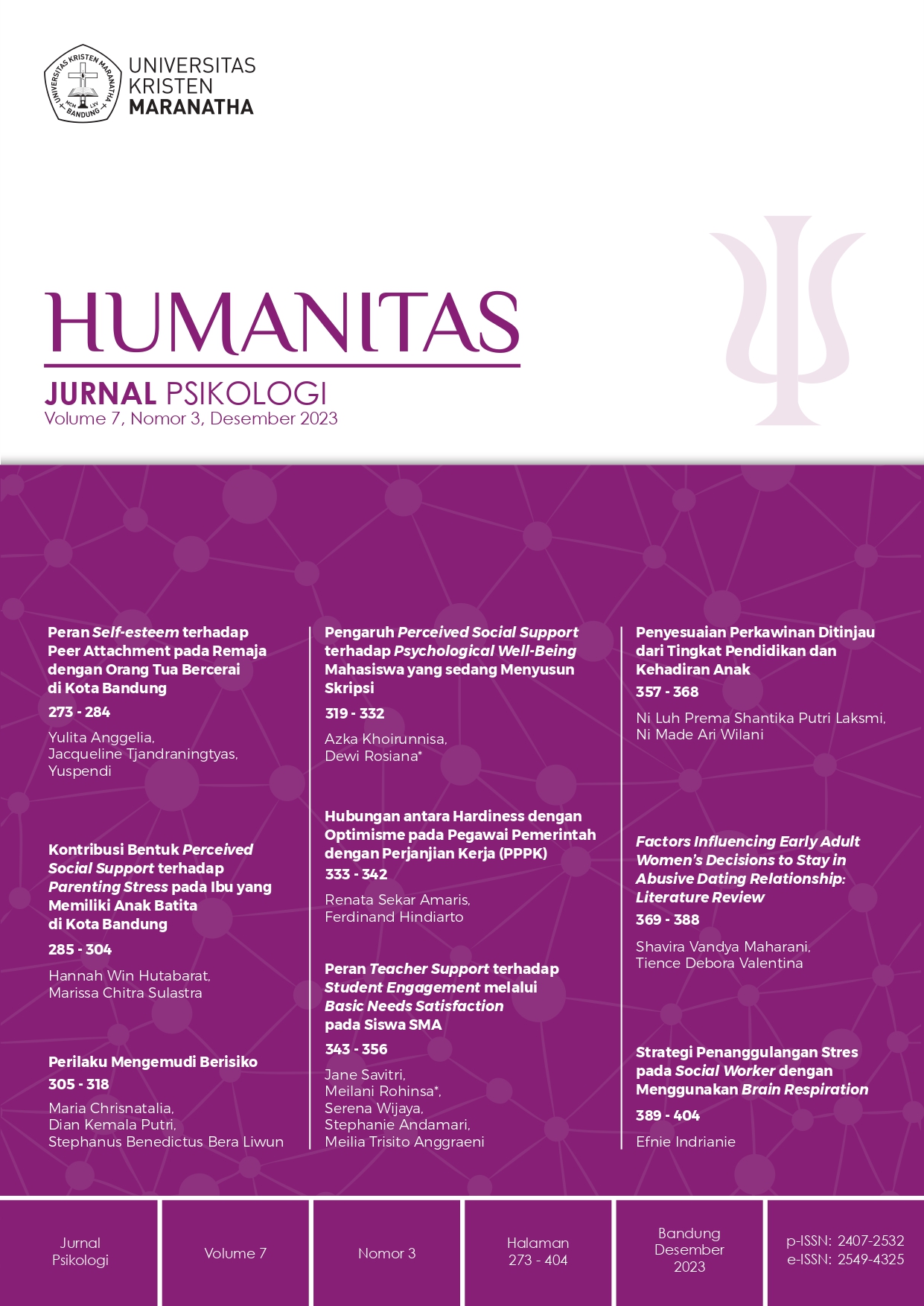Hubungan antara Hardiness dengan Optimisme pada Pegawai Pemerintah dengan Perjanjian Kerja (PPPK)
Isi Artikel Utama
Abstrak
Unduhan
Rincian Artikel

Artikel ini berlisensi Creative Commons Attribution-NonCommercial 4.0 International License.
Referensi
Arieska, R., & Rinaldi. (2019). Hubungan antara hardiness dengan optimisme pada remaja penghuni panti asuhan kota bukittinggi. Jurnal riset psikologi, 1, 1 – 12. DOI: http://dx.doi.org/10.24036/jrp.v2019i1.6528
Ausie, R.K., Wardani, R., & Selly. (2017). Hubungan antara Hardiness dan Kesejahteraan Psikologis pada Calon Bintara Korps Wanita Angkatan Darat (KOWAD) di Pusat Pendidikan KOWAD Bandung. Jurnal Humanitas. 1 (3), 209 – 219. DOI: https://doi.org/10.28932/humanitas.v1i3.758
Badan Kepegawaian Negara. (2021). Statistik ASN Desember 2021. Badan Kepgeawaian Negara: Jakarta. Diunduh dari https://www.bkn.go.id/unggahan/2022/06/STATISTIK-PNS-Desember-2021.pdf
Badan Kepegawaian Negara. (2022). Buku Statistik. Aparatur Sipil Negara. Badan Kepegawaian Negara: Jakarta. Diunduh dari https://www.bkn.go.id/publikasi/statistik-pns/
Citraningtyas, C.E. (2021). Addressing optimism among the young Indonesia generartion in sustaining pandemic. Jurnal ilmu sosial dan humaniora. http://dx.doi.org/10.23887/jish-undiksha.v10i2.33469
Fitriani, E.D. (2021). Menaker: ASN Harus Punya Semangat Kembangkan Hard Skill dan Soft Skill. Diakses dari https://news.detik.com/berita/d-5685690/menaker-asn-harus-punya-semangat-kembangkan-hard-skill--soft-skill
Humas MenPanRB. (2020). Menteri Tjahjo Ingatkan ASN untuk Terus Tanamkan Semangat Bela Negara. Diunduh dari https://menpan.go.id/site/berita-terkini/menteri-tjahjo-ingatkan-asn-untuk-terus-tanamkan-semangat-bela-negara.
Baik, Kuat, dan Akhalkul Kharimah. Diakses dari https://pu.go.id/berita/menteri-basuki-asn-harus-memiliki-karakter-yang-baik-kuat-dan-akhlakul-karimah
Kobasa, S.C. (1979). Stressful life events, personality, and health: an inquiry into hardiness. Journal personality and social psychology. 37 (1), 1 – 11.
Kobasa, S.C., Maddi, S.R., & Kahn, S. (1982). The story of hardiness: twenty years of theorizing, research, and practice. Consulting psychology journal: practice and research. 54 (3), 175 – 185. DOI: 10.1037//1061-4087.54.3.175
Komisi Pemberantasan Korupsi. (2021, September 16). (Webinar) Jual Beli Jabatan, Kenapa dan Bagaimana Solusinya?. Youtube. Diakses dari https://www.youtube.com/watch?v=qhYip_HYYy0
Liputan6. (2021, Juli 27). Menteri PANRB: Total Pendaftar CPNS 2021 dan PPPK Capai 4.030.090 Orang. Diakses dari https://www.liputan6.com/bisnis/read/4617023/menteri-panrb-total-pendaftar-cpns-2021-dan-pppk-capai-4030090-orang
Maddi, S.R. (2013). Hardiness: turning stressful circumtances into resilient growth. United State of America: Springer
McGinnis, A.L. (1990). The power of optimism. New York : Harper & Row. Diunduh dari https://archive.org/details/powerofoptimism00mcgi/page/n11/mode/2up?view=theater
Nurtjahjanti, H., & Ratnaningsih, I.Z. (2011). Hubungan Kepribadian Hardiness dengan Optimisme Pada Calon Tenaga Kerja Indonesia (CTKI) Wanita di BLKLN Disnakertrans Jawa Tengah. Jurnal Psikologi Undip. 10 (2), 126 – 132.
Peraturan Pemerintah Nomor 49 Tahun 2018 Manajemen Pegawai Pemerintah dengan Perjanjian Kerja. (2018, November 28). Lembaran Negara Republik Indonesia Tahun 2018 Nomor 6264. Diunduh dari https://peraturan.bpk.go.id/Home/Details/99181/pp-no-49-tahun-2018
Ruhyani, Y. (2021, September 04). Wujudkan ASN Profesional, Optimis, dan Produktif, SDM BRIN Pelajari Strategi Mengelola Isu dan Manajemen Krisis. Diakses dari http://lipi.go.id/berita/wujudkan-asn-profesional-optimis-dan-produktif-sdm-brin-pelajari-strategi-mengelola-isu-dan-manajemen-krisis/22499
Seligman, M. E. (2008). Menginstal Optimisme Bagaimana Cara Mengubah Pemikiran dan Kehidupan Anda. Bandung: Momentum.
Sugiyono, Dr. (2013). Metode Penelitian Kuantitatif, Kualitatif, dan R & D. Bandung: Penerbit Alfabeta. Diakses dari https://anyflip.com/utlqr/qtha/basic
Tyas, R.C., Cahyadi, A. (2022). Keterkaitan kepribadian hardiness dengan optimisme dalam mencari pekerjaan pada dewasa awal. Psycho idea, 20 (2), 118 – 127. Diunduh dari https://jurnalnasional.ump.ac.id/index.php/PSYCHOIDEA/article/view/13447/5105
Winarno, M.E. (2011). Metodologi Penelitian dalam Pendidikan Jasmani. Malang: Penerbit Universitas Negeri Malang. Diunduh dari file:///C:/Users/lenovo/Downloads/BukuMetodologiPenelitian.pdf
Zahid, A., & Antika, E.R. (2022). Pengaruh kepribadian hardiness dengan optimisme masa depan pada siswa MAN 2 wonosobo. Jurnal bimbingan dan konseling Indonesia, 7 (2), 1 – 12. Diunduh dari https://ejournal2.undiksha.ac.id/index.php/jurnal_bk/article/view/1390

